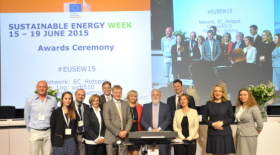Cohesion Policy Investments in Sustainable Energy
Highlights from the EU Sustainable Energy Week
Brussels, 29 June 2015 | Published in Energy, Economy
On 15-19 June the European Commission and the Committee of the Regions organised the EU Sustainable energy week, a three-day Policy Conference in Brussels (#EUSEW15). A wide range of stakeholders attended the events: public authorities, researchers, energy agencies, private companies, NGOs and associations. Our Policy Assistant, Edit Lakatos participated to events relevant to the use of Structural Funds on energy efficiency and reports the main outcomes.
Cohesion Policy Investments in Sustainable Energy 2014-2020
In total, 38 billion euros ware available in 2014-2020 on low-carbon economy (this includes energy efficiency, renewable energy production and use, smart distribution grids and sustainable urban mobility, also research and innovation in these areas). The support comes from ERDF and CF with complementarity with Horizon 2020.
In the frame of energy efficiency, housing, public buildings and industrial buildings development will be supported. The information is already available: the largest amount will be available relating to housing!
Out of this, 2 billion of ERDF support is dedicated only for development of smart systems (electricity and gas).
Its important to highlight that the financial resources are doubled compared to the previous period. For the EU, this also goes well beyond the minimum allocations required by the new regulatory framework, approaching almost 50 % more than required.
Grants and loans in the ESIF (European Structural and Investment Funds- ERDF, ESF, CF)
In 2014-2020, 88 % of ESIF will be available as grants (for deep renovation and social housing), other part as loans. It is important that the renovation loan is based on a risk sharing loan model.
According to the European Commission, in order to decide if grants or loans are necessary, the Commission should analyse the market before. The ex-ante assessment was indispensable in this regard in the recent period. The situation differs from country to country.
Grants should be used as complement to support, for example deep renovations of buildings going beyond minimum energy performance requirements, to help develop innovative technologies or to address social issues exacerbated by the crisis in many regions, such as fuel poverty.
Read MoreLink between ESIF (ERDF, ESF, CF) and EFSI (Juncker Plan)
The European Commission considers EFSI as part of the Cohesion Policy framework. ESIF and EFSI are complementary. They do not overlap, and they are not part of each-other. They are only complementary. The Investment Plan delivers 20 % of the ESI Funds allocations to low-carbon-economy.
Cohesion policy is playing a key role in delivering the Energy Union on the ground, with significant opportunities for sustainable energy.
Investment Framework for Energy Efficiency
During the second conference, different representatives and stakeholders were talking about the necessity of the energy efficient solutions. According to Mr Maros Sefcovic (Vice-president of the European Commission responsible for Energy Union), 50 % of the EU housing stock is not energy efficient. Further, the energy dependence on imported energy has been increasing since the 90’s, now the EU is 100% dependent.
Mr Maros Sefcovic highlighted that in the EU, we need a better understanding of the project management, financial support and we should boost the demand for investments. The finance is coming from both public (Cohesion Policy) and private sector (banks, long time investors other financial intermediaries) as the public funding is not enough.
In his presentation, Stefan Appel (Head of Unit, DG REGIO, B.3., European Commission) pointed out the Cohesion Policy contribution to low carbon economy through ERDF and CF. Amongst others like smart distribution, renewable energy, research and innovation, energy efficiency receives the largest share of funding for low carbon economy. The implementation of these Instruments allows for standardisation and customising. He stressed the main principles: Leverage effect, Revolving nature and Better quality of projects.
Adrian Joyce -secretary general of the European Alliance of Companies for Energy Efficiency in Buildings (EuroACE), and Renovate Europe campaign director pointed out that investing in energy efficiency in buildings is the cheapest, fastest and most effective way to decrease our energy dependency by reducing our energy demand.
EU is spending more than €1 billion every day to import the energy it needs. By renovating the EU building stock, we could push the EU Energy Dependence Day back to 26 October. Nonetheless, mobilising the necessary funding and channelling the investment to energy efficiency projects remains a challenge.
As to the EFSI, no ring-fencing for energy efficiency projects has been included in the Regulation, and would be better to focus on investments in building renovation while using the fund in practice. The EU should and could do more when investing in energy efficiency in buildings.
Finally, he stressed that investing in deep renovation of buildings would significantly ease the issue of energy dependence. For more information
